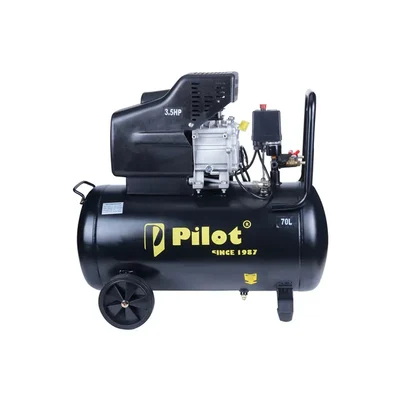- Farm & Garden
- Pumps & Motors
- Food Processing
- Workshop, DIY & MRO

Brand: Pilot
Pilot 70L Tank, 3.5 HP Motor Direct Driven Air Compressor (PL-70)
SKU: TB-PI-45911 Delivery By: Dec 9 - Dec 11
Delivery By: Dec 9 - Dec 11 




MRP : ₹15500 ₹12299
21% OFF!
 Delivery By: Dec 9 - Dec 11
Delivery By: Dec 9 - Dec 11 
Easy Return
& Refund
& Refund

Quality
Assurance
Assurance

Trusted
Delivery
Delivery

After Sales
Assistance
Assistance

Buyer
Protection
Protection
₹12299 (Including GST)
MRP : ₹15500
21% OFF!
Get Extra ₹184 OFF on Prepaid Orders
Short Description
Pilot 70L 3.5 HP Direct Driven Air Compressor
8 Bar Max. Pressure
Country of origin: India
Specifications
- Brand: Pilot
- Max. Pressure : 8 bar
- Weight (Approx.) : 28 kg
- Tank Capacity : 70 liters
- Model No. : PL-70
- Power : 3.5HP
- Tank Capacity : 70L
- Max. Pressure : 8Bar/115PSI
- Air Displacement : 256L/min
- Speed : 2850 RPM
- Voltage : 220V/50Hz
Description
The Pilot Direct Driven Air Compressor offers superior performance with its robust 3.5HP motor and a larger 70L tank, designed for medium-scale industrial and professional tasks. This compressor is built for efficiency and durability, ensuring you get the job done faster.
Features
:- High Power Output : 3.5HP motor delivering a strong air displacement of 256L/min.
- Built to Last : High-quality materials ensure durability and long-term use.
- Safety Auto Cut-Off : Shuts off automatically at 8 Bar/115 PSI to prevent over-pressurization.
- Fast & Efficient : Operates at 2850 R.P.M for smooth and rapid air delivery.
- Larger Capacity : With a 70L tank, it provides longer air supply, reducing the need for frequent refills.
Applications
:- Automotive & Garage : Ideal for inflating tires, running air tools, and powering pneumatic systems.
- Construction & Carpentry : Perfect for nail guns, staplers, and other construction tools.
- Industrial Use : Suitable for airbrushing, cleaning, and equipment maintenance.
Usage
:Usage Instructions :
Safety First
- Read and understand the user manual before operation.
- Always wear safety gear: goggles, gloves, and hearing protection.
- Operate in a well-ventilated, dry area away from flammable materials.
Setup
- Place the compressor on a flat, stable surface.
- Ensure the power supply matches the motor rating (usually 230V, 50Hz single-phase).
- Check oil level (if oil-lubricated) before starting.
- Inspect for any transport damage or loose fittings.
Starting the Compressor
- Connect to the power source.
- Turn ON using the pressure switch or ON/OFF button.
- Allow the tank to pressurize (watch the pressure gauge).
- The motor will stop automatically once the cut-out pressure is reached.
Connecting Tools
- Use an appropriate air hose rated for the pressure.
- Connect air tools using quick-connect fittings.
- Adjust the outlet pressure using the regulator knob to match the tool's required pressure.
Operation
- Monitor pressure gauges during use
- Tank pressure : Total pressure stored.
- Outlet pressure : Pressure supplied to the tool.
- Avoid continuous operation beyond the duty cycle (typically 50%-75% for direct drive).
- Let the unit rest between cycles to avoid overheating.
Shutting Down
- Turn off the compressor.
- Disconnect power.
- Release pressure from the tank via the drain valve or safety valve.
- Store in a clean, dry area.
Maintenance :
Daily Checks
- Inspect for air or oil leaks.
- Drain condensation from the air tank via the drain valve (bottom of the tank).
- Check oil level (if applicable).
- Ensure the air filter is clean.
Weekly Maintenance
- Clean the air filter with compressed air or replace if dirty.
- Inspect safety valve operation - pull to check it releases pressure.
Monthly Maintenance
- Check oil quality (for oil-lubricated models):
- If dark or contaminated, replace.
- Inspect power cord and connections for damage.
- Tighten loose nuts, bolts, or fittings.
Oil Change (Every 3 Months or ~100 hours)
- Warm up the compressor for 2-3 minutes.
- Turn off and unplug.
- Remove the oil drain plug and drain into a container.
- Refit the drain plug.
- Refill with compressor-grade oil (SAE 30 or equivalent) to the correct level.
- Do not overfill.
Annual Maintenance
- Inspect pressure switch and motor for wear.
- Clean cooling fins and fan to ensure proper airflow.
- Inspect tank for internal corrosion (done by a technician if needed).
Storage Tips
- Store in a dry, clean location.
- If storing long-term : Drain all air and moisture, Cover to prevent dust ingress, Disconnect from power.

Select attribute










